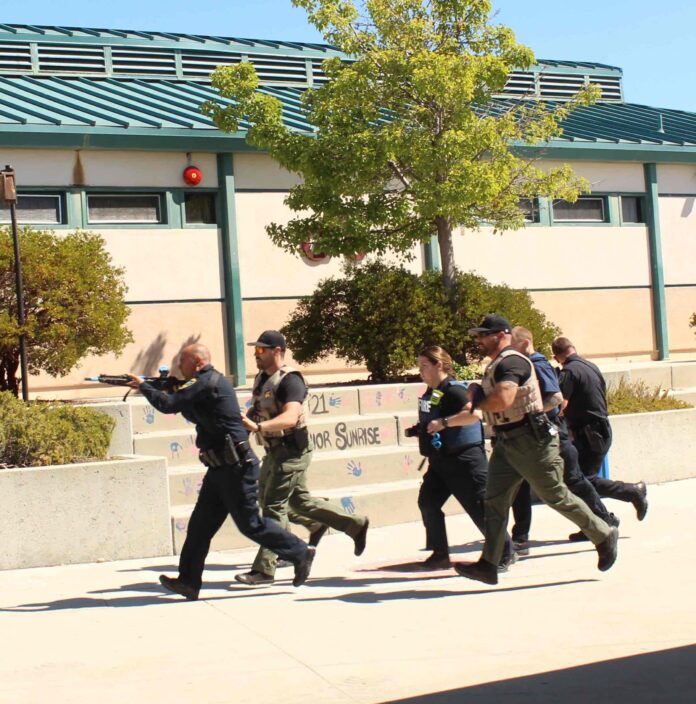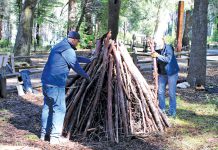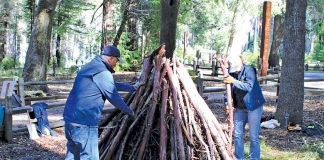
Officers and firefighters running through “active shooter” drills at Scotts Valley High School had to make a quick shift into a real-world situation on June 24, when a participant’s comment about a potential threat at the campus sparked an hours-long hunt for danger.
In the end, police determined it was nothing more than an inappropriate “joke,” but it gave dozens of law enforcement and fire officials the chance to put morning lessons into action in an authentic situation that very afternoon.
“We had to search everything,” said Capt. Jayson Rutherford, of the Scotts Valley Police Department. “You can never take it too seriously.”
About 40 different agencies have been participating in the day-long exercise, which runs from June 21-29.
That includes personnel from UC Berkeley, UC Davis and Sonoma State, California Highway Patrol, Cal Fire, the Bureau of Alcohol, Tobacco, Firearms and Explosives, California Division of Occupational Safety and Health, California Department of Fish and Wildlife, and California State Parks.
“We train in the neighborhood of 400 first responders over the course of the event,” Rutherford said. “It’s quite the undertaking.”
The 10-hour training is limited to about 30 officers and 40 firefighters each day.
“If there’s a critical incident here, there’s going to be agencies that come from all over,” he said. “It’s important for us to know who’s in our allied agencies … so we know how they work and they know how we work.”
The training has been held in Scotts Valley for about a decade, but the trend has been to incorporate firefighters more closely into the emergency response.
Rutherford said trainees learn how to create a “safety corridor” so firefighters can move into position in an area of “warm” danger—but away from the “hot” zone.
“They can start triaging patients a lot faster,” he said. “They wear helmets, they wear bulletproof vests.”
This can shave half an hour to an hour off the medical response, according to Rutherford.
“The survivability rate is much higher,” he said. “People aren’t bleeding out.”
Similarly, police carry tourniquets and learn tactical first aid.
Coursework
The day begins with a safety briefing.
Attendees are searched, as no live ammunition is allowed on site.
Participants are broken up into two groups, with firefighters and police in each group.
One trains on strategy—such as proper entry techniques and tracking down the threat—the other studies about rendering aid and how to transport patients.
Midway through the morning, the groups swap, until it’s time for an on-campus lunch.
During the afternoon, attendees get more hands-on with training.
“We have live, active shooter-type drills,” Rutherford said. “There are bad guys shooting at us; we shoot at them.”
While bullets aren’t used, munitions are, making the training similar to playing paintball, he added. Volunteer actors are assigned roles, such as an injured bystanders.
Meanwhile, leaders learn how to run a command post as the action unfolds.
As some of the police contingents seeks to neutralize the shooter, others serve as bodyguards escorting firefighters as close to the unfolding events as possible.
While the training took place at Scotts Valley High School, Rutherford said the skills attendees learn could be helpful in a variety of circumstances.
“The mindset is, ‘this could happen anywhere,’” he said, but adds the significance of the training is underscored by the setting. “When you’re talking about schools you’re talking about children.”
Top of Mind
As the Scotts Valley training unfolded, Congress passed the most significant gun reform bill in decades, although it didn’t ban assault weapons.
This came in the wake of the May 24 killing of 19 students and two teachers in Uvalde, Texas at Robb Elementary School, on top of other recent mass shootings.
The day after that tragedy, a boy at a school just 16 miles from SVHS—Fisher Middle School in Los Gatos—threatened to “shoot up the school,” and police seized a shotgun from his dad’s house.
On May 26, San Jose held a memorial marking the one-year anniversary of the Valley Transportation Authority mass shooting that killed nine people, including a former Scotts Valley resident, before the gunman committed suicide.
Ruth Stiles, the Director of the Scotts Valley Water District, spoke during the public comment period at the June 15 Scotts Valley City Council meeting (but not in an official capacity) to demand the City do more to prevent something similar from happening here.
“It just seems like there are so many guns in this community,” she said. “Let’s make sure they’re kept out of the hands of people who don’t know how to use them—and keep them safe.”
In her reply, Mayor Donna Lind, a retired SVPD officer, said gun locks are available for free in the lobby of the police station.
Officers will assist people with surrendering their weapons safely, she said.
“That doesn’t mean we can’t look at more,” she said, indicating a willingness to explore additional measures.
Kathy Hundemer, a retired school nurse, urged council to approach gun violence as if combatting a contagious disease.
“I believe our leaders need to take a public health approach,” she said. “It can be interrupted and slowed down.”
Training Interrupted
On June 24 at SVHS—the same day members of the media were invited to see how officers were learning to respond to an active shooter—things shifted into something much more serious.
One of the actors made a comment about a potential threat on the premises that was serious enough it couldn’t be ignored, Rutherford said, declining to describe the precise nature.
“It was a joke, and it wasn’t taken as such,” he said.
The man wasn’t one of the firefighters or police officers undergoing training, he confirmed, adding it was determined not to be a “swatting” action meant to intentionally disrupt law enforcement and firefighters.
Starting around 4:30pm, authorities were suddenly thrust into a real-world scenario, as they swept the campus and interviewed the role-players to assess the situation.
“It took several hours,” Rutherford said. “It was an opportunity to use a lot of skills that we had just learned in terms of managing a large-scale event with multiple agencies.”
The potential threat resulted in trainees staying about an hour later than originally planned; Scotts Valley police continued searching the school grounds into the night, just to be sure.
It was unclear whether the man who made the “joke” would face any consequences.









